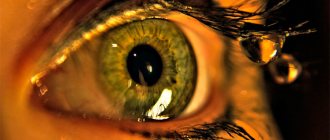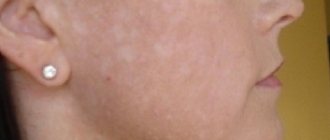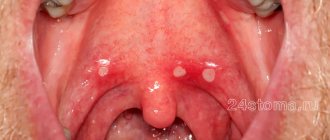Angiomas (red moles) are one of the forms of benign neoplasms. They do not harm the body and rarely become malignant. But dermatologists and oncologists recommend periodically examining these formations, especially if they increase in size.
Typical locations are neck, chest, back. Red dots appear due to changes in the condition of the capillaries. If you press on a mole, it begins to fade, then turns red again. It is characterized by sudden appearance and disappearance, often the structure resolves. Angiomas can appear in children and adults, but are usually characteristic of childhood.
Reasons for appearance
Angiomas occur in newborns. They are formed due to viral and bacterial diseases suffered by a woman during pregnancy. For example, ARVI, influenza, pyelonephritis. The formations have different sizes, but do not exceed 1 cm. Up to 7 years of age, they most often resolve on their own. Adults are characterized by hormonal changes, after which red moles appear.
There are no reliable data on the nature of the formation. There are only hypotheses.
- Changes in hormonal levels. For example, adolescence, pregnancy, lactation, menopause.
- Damage to skin and blood vessels. They must be chronic. For example, frequent damage after shaving.
- Hypovitaminosis. If there is a lack of vitamins K, C, E, D, the vascular endothelium begins to become thinner and damaged.
- Digestive disorders. Moles can form due to frequent inflammatory conditions. For example, gastritis, enteritis, colitis.
- Liver pathologies. Angiomas take on a bright red hue.
- Cardiovascular diseases leading to fragility of blood vessels. This is anemia, hemophilia.
- Lipid imbalance, autoimmune lesions.
- Unfavorable heredity.
- Bad habits. These include frequent consumption of alcohol and nicotine. Visiting a solarium is also harmful.
People at risk should have their moles examined periodically by a dermatologist.
Locations
Red moles form in places such as:
- Skin covering;
- Bones;
- Muscles;
- Internal organs, most often the liver, kidneys, lungs;
- Brain (there is a high risk if a mole enlarges quickly);
- Fat layer;
- Mucous membrane.
Simple angiomas occur on the skin of the face and head (80% of cases), and cavernous angiomas are located under the skin, penetrating muscle and bone tissue, as well as not only on the surface of internal organs, but also inside them.
Classification
Angiomas are divided depending on the type of affected vessel:
- capillary;
- venous;
- arterial.
Classification depending on the degree of penetration into the epidermis:
- flat;
- convex.
The table shows the classification by cellular and tissue composition.
| Variety | Characteristic |
| Branched | Convex, containing blood inside. After pressing, the shade disappears, then turns red again |
| Flat | Completely embedded in the epidermis. Rarely damaged due to the influence of mechanical factors, as they do not cling to foreign objects |
| Pineal | They have a spherical shape, slightly convex |
| Star-shaped | Branches in the form of cobwebs extend from the rounded center |
| Knotty | They have a burgundy or dark purple color. Most often localized on the wing of the nose or in the corner of the lips |
| Cavernous | They are most often located on the face, going in a chain one after another. Large sizes spoil the appearance |
If the angioma grows over time and becomes excessively large, it turns into a hemangioma. Its diameter can be up to 3 cm. The mole is susceptible to injury, so it is better to remove it surgically.
Symptoms
The following signs are characteristic of the neoplasm:
- red, purple, burgundy, bluish tint;
- a change in color is more often characteristic of a malignant process;
- usually this is a single formation, if they gradually increase in size and spread more and more throughout the body, contact a dermatologist (this is a sign of vascular pathologies);
- complete absence of discomfort.
The mole should not itch, hurt or itch. If these signs occur, it is most likely not an angioma.
Features and advantages of laser technology
Many people prefer to remove moles using a laser. This technique has a number of advantages, including:
- high performance. It is possible to completely get rid of angioma in one procedure;
- comfort. Laser removal is carried out using modern anesthetic substances, so the patient does not experience any discomfort;
- availability. The prices for the technique are low;
- short duration. It takes no more than 20 minutes. The exact time depends on the size and number of moles;
- lack of long-term rehabilitation;
- safety (no bleeding or risk of infection).
Contraindications to the technique are minimal. It cannot be performed in the presence of infectious diseases, diseases of the cardiovascular system, lesions of the central nervous system, which are characterized by increased excitability. The doctor will tell you more about the possibility of using this technology after the examination.
Consequences, complications
If no changes occur in the structure of the angioma, it is completely harmless to humans. Over time, it may completely dissolve. But there are cases when the formation turns into a malignant form due to the appearance of atypical cells. This can occur under the influence of damaging factors:
- frequent mechanical damage;
- large volume of ultraviolet rays.
If in children moles are located in the corners of the eyes, wings of the nose, and are large in size, this can lead to negative consequences:
- difficulty or decreased visual acuity;
- change in sense of smell.
If the size of a mole in young children is not minimal, they must be carefully examined to prevent complications.
Diagnostics
The exact causes of a red mole have not been established, but methods for its diagnosis and treatment have been developed at a high level.
Types of examination to establish the correct diagnosis:
- Taking an anamnesis - the doctor asks questions about the existence of a similar mole among the patient’s family members, about the possible reasons for its appearance and changes;
- Referral to a more specialized specialist - dermatologist, surgeon, oncologist, endocrinologist, gastroenterologist, neurologist;
- Dermatoscopy – the doctor conducts an external examination of the birthmark;
- Digital dermatoscopy is a digital image of a mole taken using a dermatoscope and displayed on a computer screen. The possibility of such magnification and examination of the birthmark simplifies the study;
- Biopsy is a method for diagnosing malignant neoplasms; if this procedure is carried out correctly, the result is 100%. Types of biopsy: Puncture - a piece of tissue is taken with a needle in a limited amount under anesthesia;
- Total excision is also a therapeutic procedure in which tumors are removed or used for histological testing;
- Ultrasound;
When is treatment required?
Most often, angiomas do not cause discomfort or threaten health, so dermatologists do not recommend treating them. Surgical removal is indicated only in the following cases:
- visual defect, for example, when a large formation is located on the face;
- frequent mechanical damage due to inconvenient location (in the shaving area, bra wire);
- change in shade;
- increase in size;
- discomfort at rest or when pressed.
With negative symptoms, contact a dermatologist. A general examination is not enough. It may be necessary to conduct laboratory and instrumental tests to determine the degree of malignancy and the cause of negative signs.
Self-treatment and removal of moles at home is strictly prohibited. This can lead to complications. For example, bleeding, malignant degeneration, increase in size.
The only treatment method is surgery. The use of gels, ointments and other conservative remedies does not help. They can only improve the condition of the skin (moisturize, eliminate inflammation, prevent the effects of ultraviolet rays).
Types of red dots on the body
Red moles of vascular origin are called angiomas. If the cause of such a neoplasm is a defect in the blood vessel, then the mole is called a hemangioma, and if it is lymphatic, then a lymphangioma. While hemangiomas can appear on the body in any area, lymphangiomas are usually localized in areas of greatest concentration of lymph nodes:
- in the mouth,
- on the neck,
- in the armpit area,
- in the groin area.
Hemangiomas themselves, or tumor formations associated with malformation of blood vessels, are most often congenital in nature, and their formation is associated with various pregnancy anomalies. Hemangiomas are divided into superficial and deep. Superficial, as the name implies, are located in the skin and are colored bright red or red-violet. They may appear as flat spots or raised papules of varying shapes or sizes. Such tumors are considered benign and usually do not cause significant discomfort. However, if they are located on the scalp or in the inguinal/perianal areas, these growths may be at risk of ulceration with subsequent infection. In this case, exudate with an unpleasant odor may appear, or the tumor becomes covered with a black or yellow crust and becomes painful and may itch.
Only qualified specialists can choose the correct treatment for red dots
Deep hemangiomas can affect internal organs, most often without causing symptoms. However, damage to such a tumor as a result of trauma leads to profuse and difficult to stop bleeding, which can lead to death. Often, deep hemangiomas can be associated with small superficial capillary neoplasms. In this case, additional diagnostics using ultrasound or MRI will be required.
Treatment methods
Treatment methods for angioma are selected after examination. If the formation is flat, it is easier to remove than a convex one. No major pain relief is required before the removal procedure. A local anesthetic may be used. After the procedure, the affected area may bleed slightly.
After completion of the procedure, a rehabilitation period is recommended, during which exposure to sunlight on the affected area is limited.
There are many ways to remove angioma.
- Application of X-rays
. They help identify and reduce the mole. If it is small, it can be completely eliminated after a course of therapy. At the moment, the method is rarely used due to the risk of malignant degeneration. - Surgical removal
. After the procedure, the mole is completely gone. A connective tissue scar may appear in its place. Therefore, the method is used for localization in invisible areas. After the procedure, rehabilitation methods are used. For example, antibacterial powders or ointments, a ban on swimming for 1-2 days. - Cauterization with carbon dioxide
. The technique is applicable for small formations located on the upper layers of the epidermis. Therapy for large moles is not carried out using this method, since its lower layers may remain intact, so it will form again. - Chemical sclerosis
. Suitable for capillary type moles. A substance is injected subcutaneously that eliminates the effect of blood vessels. The mole stops receiving blood and gradually disappears. - Cryodestruction
. The mole is cauterized with liquid nitrogen. Due to the low temperature, the walls of the capillaries are destroyed, and a crust gradually forms. Healthy tissue will form in its place. The technique is applicable when angioma penetrates to the deep layers of the epidermis. - Coagulation
. With its help, large and small formations are removed. There are no scars left after the procedure. We will use infrared, radio wave, and light methods.
Removal is recommended if the aesthetic appearance is compromised and there is a risk of malignant degeneration.
Prevention education
To prevent the formation of angioma, prevent multiple formation of moles, damage and malignant degeneration, it is recommended to use the following rules:
- prevention of skin damage in the area of angioma;
- drink plenty of fluids to restore water and electrolyte balance and remove toxic products;
- consumption of vegetables, fruits, and other healthy foods high in vitamins K, C, E, D;
- daily bowel movements;
- no visits to the solarium or tanning in the open sun;
- the use of creams with a high degree of protection against ultraviolet rays, SPF of at least 50;
- daily skin hydration.
Despite the absence of danger from moles, it is necessary to monitor them constantly. Usually they are of poor quality, but with prolonged exposure to a damaging factor they can develop into skin cancer. If there is a risk, it is better to periodically consult a dermatologist. He will record every mole on the body, promptly identifying an increase during a re-examination.
If a mole spoils the aesthetic appearance, causes discomfort, or becomes dangerous, it can be removed in a timely manner. Many methods have been developed that can do this painlessly.
Folk way to remove moles
Once such a mole appears, it cannot disappear on its own. She needs to be treated by a dermatologist. It is not recommended to remove angioma using folk remedies. Often, instead of the desired result, extreme sports fans get burns and infections.
But, if you really want to take a risk, try applying a bandage with onion juice until it goes away.
ONLINE REGISTRATION at the DIANA clinic
You can sign up by calling the toll-free phone number 8-800-707-15-60 or filling out the contact form. In this case, we will contact you ourselves.
If you find an error, please select a piece of text and press Ctrl+Enter











